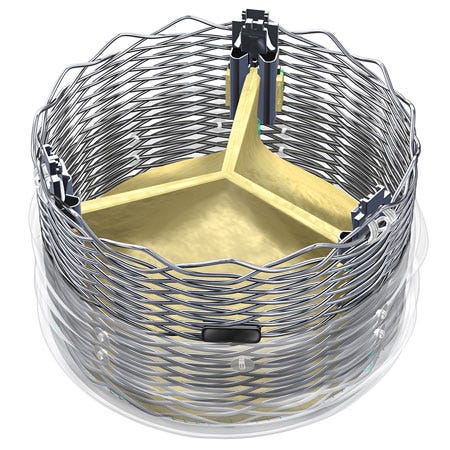Designing Next-Generation TAVI Technology
September 24, 2014
Boston Scientific has just announced the enrollment of the first U.S. patients in a clinical trial of its Lotus valve system. The company hails the device as a second-generation transcatheter aortic valve implantation (TAVI) technology, which was developed to overcome design limitations of the first generation TAVI products, which are now marketed by Edwards Lifesciences and Medtronic.
"The Lotus valve design was based on observations, in the early 2000s, of the progress of the PVT valve, which became the Edwards Sapien device, and CoreValve, which is now a Medtronic product," says Crystal Cunanan, director of materials engineering at Boston Scientific. "Right away, the founders recognized that there was [room for improvement] in the ability to have total control over the placement of the valve and to reduce paravalvular leak." (Cunanan will speak on the subject of cardiology innovations on October 30 at MD&M Minneapolis.)
A startup known as Sadra Medical was founded in 2003 to develop their technology, eventually attracting Boston Scientific's interest. Boston Scientific completed the acquisition of Sadra in 2011.
|
Boston Scientific refers to the Lotus as a second-generation TAVI valve. |
The design of the Lotus valve is unique. "The way our valve locks tight is kind of like a Chinese finger trap," Cunanan says. While a Chinese finger trap is made of a woven braid of fiber, the Lotus valve braid is made of nitinol. That allows it to be collapsible, elongated, and very flexible. Capable of fitting inside of small catheter, the device changes shape after placement. "When it is in the heart, we bring the top and the bottom together. We literally have a seat belt mechanism used to buckle the top and the bottom together to facilitate the placement of the device. Physicians implanting the device can measure and visualize it to confirm optimal placement before pulling a release pin, which separates the device from the delivery system once it is inthe optimal place. "Since, in the delivery of the valve, it is not jumping out of a catheter or expanding with a balloon, there is no movement in the final placement," Cunanan says. "It is very much: 'what you see, is what you get.'"
The ability to have total control in the placement of the Lotus valve could potentially translate to improved clinical performance, in Boston Scientific's estimation. "As you can appreciate, this is an interventional procedure. When you release the valve from a catheter, the heart is beating and everything is moving. Depending on which part of the cardiac cycle you are in, you could end up with a surprise in the positioning." As you might imagine, such a surprise is by no means welcome. If the placement ends up too high, then the structure of the valve can end up covering or "jailing" the opening of the coronary artery. "That is a clinically concerning situation," Cunanan says, "but it is equally concerning when the valve ends up too low, in which case it can become dislodged, and that can be catastrophic."
The design also connects the leaflets indirectly to the stent structure. Both the Sapien and CoreValve have designs that directly connect the leaflets to the device, which puts more fatigue on the stent structure.
The other potential advantage the Lotus could have is its ability to reduce paravalvular leak. "In a surgical valve replacement, the surgeon has stopped the heart and opened everything up, and is using scissors to cut out the old leaflets and is using 12-16 sutures to tie a bunch of knots to put the new valve in place," Cunanan explains. They are able to test the integrity of the sutures to make sure there is no leaking. "But with the TAVI valve, you are not removing the old leaflets, but simply pushing them out of the way to place the valve. Because the native leaflets and annulus don't necessarily calcify in a perfect circle," Cunanan says. "When you put in a TAVI valve in a patient like this, you sometimes end up with leakage through those various irregularities."
Crystal Cunanan, Boston Scientific's director of materials engineering, will speak about the design of the Lotus at MD&M Minneapolis on October 30, 2014. |
The Lotus valve is designed to overcome this problem through the use of an adaptive seal. "The seal is a thin polymer film that is conformal. "It is loose and when the valve is in place, it is wrinkly," Cunanan adds. "Those extra folds will fill in the irregularities around the annulus and create a seal."
Boston Scientific uses a method known as uniform fixation to process the bovine pericardial tissue used in the devices. "The method we use allows us to have very consistent behavior from one leaflet to the next, and one piece of tissue to the next," Cunanan says. The tissue is also treated with T-Guard, which has been shown to mitigate calcification in animal models. Calcification is a leading cause of longterm failure in bioprosthetic valves.
The results of a trial (separate from the aforementioned U.S. study) were published in the Journal of the American College of Cardiology. The Reprise II study, a prospective, single-arm trial design involved 120 high-risk patients with severe aortic stenosis. The pressure gradient caused by aortic stenosis was dramatically reduced. The 30-day mean aortic valve pressure gradient fell from 46.4 to 11.5 mm Hg in the study.
Brian Buntz is the editor-in-chief of MPMN and Qmed. Follow him on Twitter at @brian_buntz.
Like what you're reading? Subscribe to our daily e-newsletter.
About the Author(s)
You May Also Like


.png?width=300&auto=webp&quality=80&disable=upscale)
